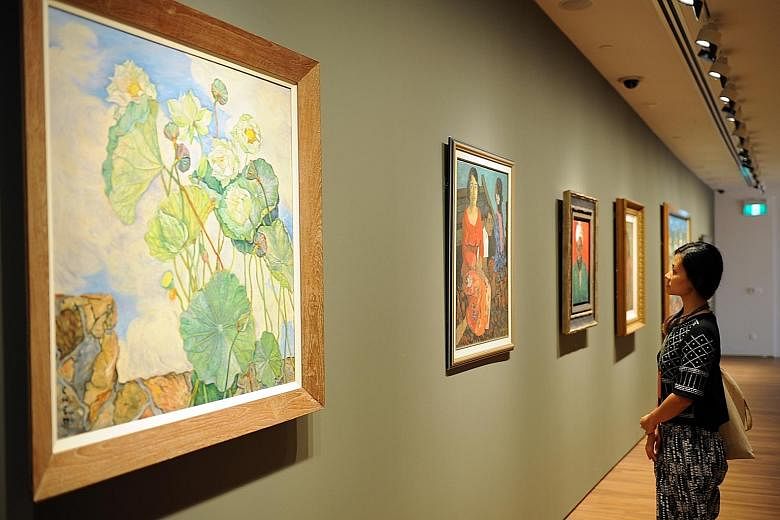"The painting at the end is my favourite," the museum security guard told me as we trailed behind a small group on a special tour of the National Gallery this week, shortly before its opening.
"Which one is that?" I asked, beckoning him to show me. "Drying Salted Fish by Cheong Soo Pieng," he said, adding, "It's on the $50 note."
"He is my favourite too," I smiled and said excitedly, referring to Mr Cheong, one of Singapore's pioneer modern artists who immigrated here from Amoy, China, in 1946 and taught at the Nanyang Academy of Fine Arts for two decades.
The painting in question, a 1978 work of Chinese ink and colour on cloth, portrays a group of Malay villagers drying salted fish in a field. It is in the Nanyang style, meaning the scene is from this part of the world - South-east Asia or South Sea as the Chinese called it, hence Nanyang - and the techniques used drawn from both Chinese and Western art traditions.
While doing research for this column, I was happy to discover that British art historian Michael Sullivan, who had lectured here in the 1950s, had said that of the important Singapore artists then, "Cheong Soo Pieng was undoubtedly the most talented".
It's always great to have an expert agree with you.
But experts should not be the only ones with views on art.
Singaporeans have many views on their favourite foods. I hope more of them will also develop a taste for art so that over time, they will become as comfortable talking about paintings and artists as they are about nasi briyani and hokkien mee.
Art, after all, is a feast for the senses and meant to evoke emotions in those who take it in, the way food has for decades done for us in Singapore.
A painting is meant to "foster emotion within the soul of the viewer", was how Picasso put it, and "no work of art should leave people indifferent".
But like many of you perhaps, I was exposed to good food early on in life but not to good art. In school, the compulsory art classes I took up to Secondary 2 confirmed that I could neither draw nor paint.
When I went overseas to pursue an undergraduate degree, though, I unexpectedly fell in love - with a painting. That experience has forever coloured the way I see the world.
I still remember how it happened. A friend and I made a day trip to London. We went to the Tate Museum and as we wandered through the galleries, I saw Henri Matisse's L'Escargot (The Snail) and was entranced. To this day, I cannot explain why that painting evoked in me such joy.
It is large work and child-like in its simplicity, the work of the French painter in old age when he was ill, confined to bed and unable to paint as he used to. But he kept on creating, by cutting and tearing pieces of paper that had been painted with gouache, or opaque watercolour paint.
To create The Snail, he had his assistants pin and paste pieces of coloured paper in a spiral that was inspired by the creature's shell. He placed complementary colours together, red next to green, orange next to blue and yellow next to mauve, for a vibrant effect.
That encounter with L'Escargot piqued my interest in art. I visited museums in Europe and the US and went on many wonderful docent tours led by volunteer guides.
Three years later, I came home and realised I knew nothing about the art of my own country or the region I lived in. So I signed up to be a docent at the Singapore Art Museum (SAM) in Bras Basah Road - the first art museum here.
The training was excellent but when I started guiding, I discovered that Singaporeans were not keen on docent tours. I spent several Saturday afternoons hanging around the SAM lobby, hoping for takers. When I approached local visitors, they would more often than not look at me apprehensively and say: "Tour? Oh, no thanks."
Foreign tourists were more receptive but they were few and far between.
I stopped guiding many years ago and since then, interest in museums and in art has grown immensely. I am sure that the docent tours at the National Gallery will be far more popular than mine were at SAM.
The gallery, which opens to the public on Nov 24, is housed in the former Supreme Court and City Hall buildings, which have been splendidly restored.
On show are highlights of the National Gallery's collection, which happens to be the world's leading public collection of modern art from Singapore and South-east Asia. It comprises over 8,000 works from the 19th and 20th centuries and includes paintings, sculptures, prints, photographs and video.
For me, this week's visit to the gallery was a chance to get re-acquainted with "old friends" I have not seen for years.
They include Hendra Gunawan's War And Peace, a work which depicts two soldiers taking a break from battle during Indonesia's War of Independence from the Dutch. It was through Indonesia's art history that I learnt the politics of painting and patronage.
I got a glimpse of Liu Kang's Artist And Model, a souvenir of his historic field trip to Bali in 1952 with three other pioneer artists - Cheong Soo Pieng, Chen Chong Swee and Chen Wen Hsi, who is the artist portrayed in the painting. They went in search of a visual expression that was South-east Asian as they evolved their distinctive Nanyang style.
I gazed at Georgette Chen's enigmatic self portrait and her gorgeous Lotus In A Breeze, the colours of which are reproduced in the magical children's gallery that awaits all visitors young in age and heart.
And I lingered before the Cheong Soo Pieng paintings.
I'm glad his Drying Salted Fish now has a special place in the heart of at least one museum security guard, who was generous enough to share that with me. We were two strangers who connected thanks to a painting.
May the opening of the National Gallery usher in more such happy encounters, and even love at first sight, for those of you reading this.


